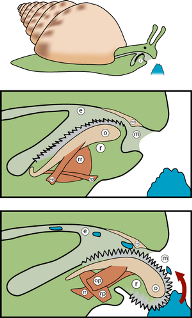In the Phylum Mullusca a majority of the animals feed by means of a radula. It is located at the base of the foot under the species head. The radula has tiny teeth that scrape up the substrate they are feeding on. Lucilla radula has narrow tricuspid teeth and short central teeth (Pilsbry,1939-48).
 Gastropods,
that are herbivores, scrape algae off of
substrates with their radula. There are
different types of feeding done by
gastropods. Some graze for their food while
others browser around.
Many Pulmonates are commonly herbivores, but
there are some who eat earthworms and other
small snails (Hickman,
2009). Once food is attached to the
radula the mouth opens; the food is then
brought into the mouth via the radula moving
backwards and moved to the pharynx. After
the pharynx, the digestion order is very
similar to every other animal. Food moves
through the stomach, then the intestine
where food gets absorbed, and then out the
anus. Lastly, the Oldfield Coil has an open
circulatory system. The blood is pumped by a
heart and runs through a series of vessels
called sinuses. There are only a few
sinuses, otherwise the blood pools over the
internal organs (Hickman,
2009). Since Lucilla inermis
lives in dry soil, they may have difficultly
retrieving food and nutrients if other
organisms do not like dryness.
Gastropods,
that are herbivores, scrape algae off of
substrates with their radula. There are
different types of feeding done by
gastropods. Some graze for their food while
others browser around.
Many Pulmonates are commonly herbivores, but
there are some who eat earthworms and other
small snails (Hickman,
2009). Once food is attached to the
radula the mouth opens; the food is then
brought into the mouth via the radula moving
backwards and moved to the pharynx. After
the pharynx, the digestion order is very
similar to every other animal. Food moves
through the stomach, then the intestine
where food gets absorbed, and then out the
anus. Lastly, the Oldfield Coil has an open
circulatory system. The blood is pumped by a
heart and runs through a series of vessels
called sinuses. There are only a few
sinuses, otherwise the blood pools over the
internal organs (Hickman,
2009). Since Lucilla inermis
lives in dry soil, they may have difficultly
retrieving food and nutrients if other
organisms do not like dryness.
Lucilla inermis does not have any information currently accessible about its nutrition. Information about the types of food it eats is not known at the moment.
If you would like to learn more information on animal nutrition or any basic animal characteristics check out Animal Diversity Web. The site can help you find facts about all types of animals, not just Mulluscs.
